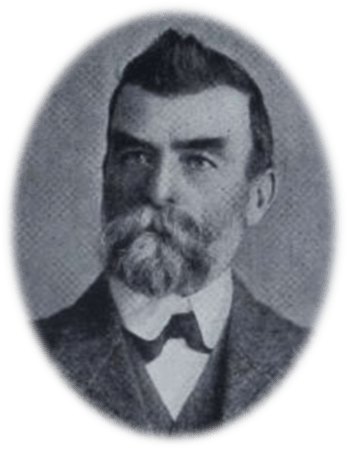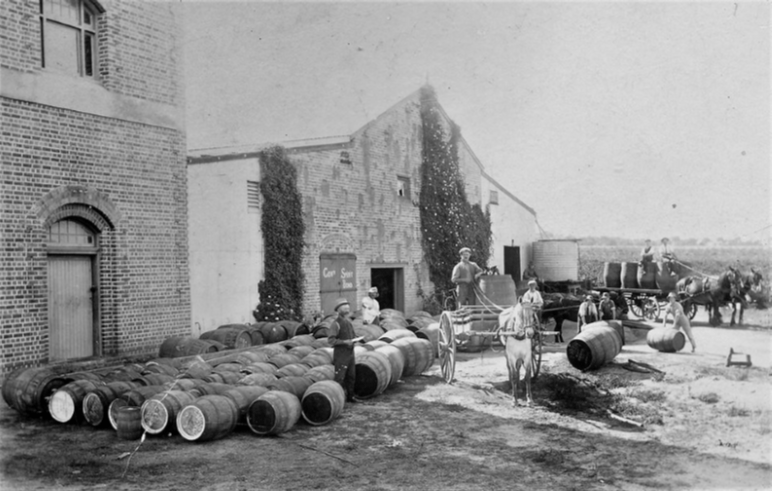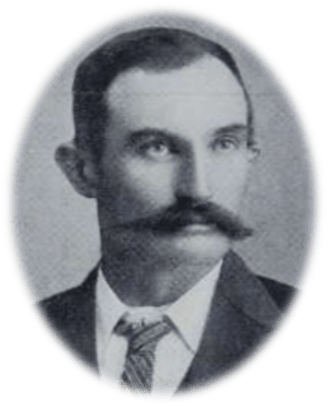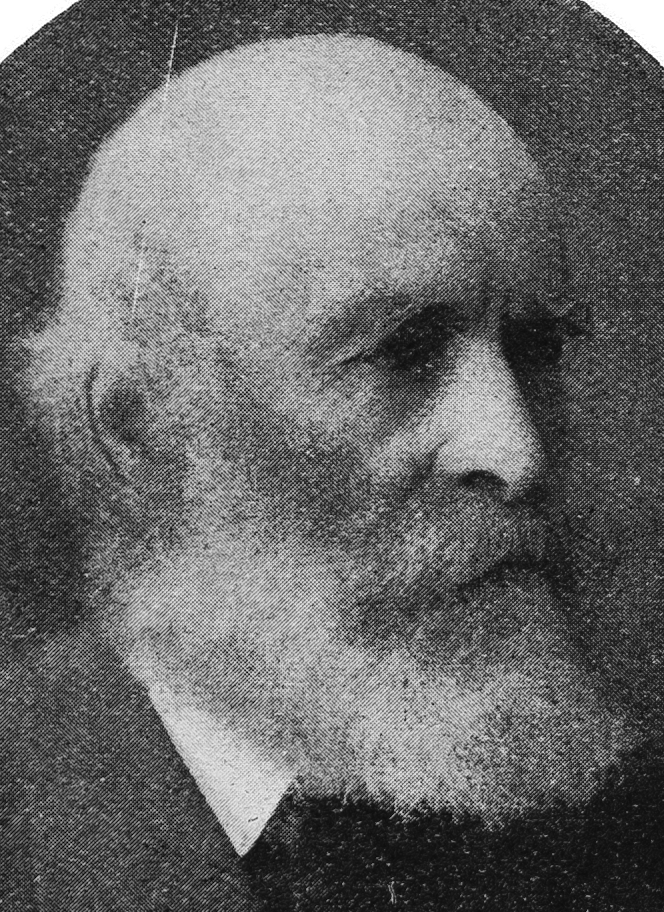South Australian Influence. South Australian Influence. South Australian Influence. South Australian Influence.
South Australians made up a large proportion of settlers in Katanning following a series of drought years in that state. Many were of German origin who had arrived in Australia escaping persecution in Germany and Austria because of their Lutheran beliefs.
The following is an excerpt from a report appearing in the Adelaide Advertiser on 26 October, 1912 about some of those South Australian settlers.
MY NOTE-BOOK IN THE WEST.
SOUTH AUSTRALIANS EVERYWHERE.
The Adelaide Advertiser
26 October, 1912
By the Hon. Ebenezer Ward.
Perth, October 3.
A Party of South Australians.
When the shades of evening were approaching and two special trains were in readiness for Bunbury or Perth in one direction, and for Katanning and Albany in another, there was a general and keen demand for seats. I had elected to go on at once to Katanning and I found a good seat in a carriage which had been directly reserved for emergencies. Presently there entered
two gentlemen with a lady and her daughter. We five were the only occupants of
the compartment all the way to Katanning, and it transpired that we were all
South Australians.
While in Western Australia, it was evident that South Australians had taken possession of a large proportion of the land.
One was Mr. James Fairclough, formerly of Mount Barker, South Australia, where his family were farmers. I specify South Australia, because there is a fruit-growing district called Mount Barker between Katanning and Albany.
Mr. Fairclough is now the proprietor of the Federal Hotel at Katanning, and has recently gained gratitude and fame by finally winning, on his own appeal to the Privy Council, a case which had been decided against him in the State courts, in which the question of “tied houses” obligations was involved. Mr. Fairclough has successfully championed the great principle of freedom of contract, and the fact is worth recording, although I cannot quote all the details in this column.
The other gentleman was Mr. John Squires, also from Mount Barker, and the two ladies were his wife and daughter. Mr. Squires will be remembered as an enterprising blacksmith at Mount Barker, and he is now not only blacksmithing at Katanning, but is to the front in agricultural implement and machinery making.
The special train reached Katanning before 10 p.m. but, late as it was and long as our day had been, so many old and some present South Australians were about that sleep was out of the question for some hours yet, although I was glad to postpone note-taking until next day. Then indeed, I was busy enough, for at least every other man I met in the town was from South Australia, and some ladies also.
Friends in Katanning.
Prominent in the main street is Mr. Edward Gilbert, chemist and druggist, who was for more than 20 years in business at Quorn, and is now, and has been for eight years, practicing his profession here.
Mr. Robert Lawson Richardson, who has one of the largest commercial businesses in the town, with branches in adjacent centres, is a son of Mr. William Richardson, of Dalveen, Woodchester, and a cousin of the late Mr. Adam Watson Richardson, chemist, of Mount Barker. Mr. Richardson derives his Christian cognomen from a daughter of Mr. Allan Bell, of Mount Barker, who afterwards became Mrs. Robert Lawson of Pathaway Station South-East. The founders of the families were fellow passengers to South Australia in 1839.
I had met Mr. Richardson at Kojonup, where he introduced me to several other old Souths who are settled in that part of the district, including Mr. Bignall, formerly of the Meadows, Mr. Charles Gunter, butcher, of Quorn; Mr. Walter Hagerty, from Boolcunda and Mr. William Yates, also from Boolcunda.
Mr. E. L. Holly, from Morphett Vale, is prospering by farming at Katanning. Mr. E. Lethbridge, an old resident of Manuanarie, is doing veterinary work at Katanning. Mr. Carl Bunnerth, formerly at the Penfold Vineyard at Magill and at Highercombe, I found in charge of the wine cellars at the Katanning vineyard; and Mr. F. H. Harrison is general manager _ there. He was for 21 years fruit-growing at Renmark, where his father still is.
I also met Mr. D. T. Edmunds, who is practicing his profession as an architect at Katanning. He is a son of Mr. R. H. Edmunds, of Adelaide. Also Mr. George Mauser, from Laura. A son of Mr. John Hendry, formerly of Mount Pleasant and Georgetown, is in business as a storekeeper at Barton.

Charles Ferdinand Wanke
A Prosperous South Australian.
Another prominent and prosperous South Australian. Mr. Charles Ferdinand Wanke, who was born in Lobethal and for some years was in the agricultural implement business at Caltowie and Mannum. He told me he used to attend my electioneering meetings before he was old enough to have a vote.
He came to Katanning in search of land in 1900, and he assures me that having seen the district he had no desire to look further. He purchased the freehold estate of Noojipin, which was first taken up 50 years ago by Mr. Andrews, a pioneer settler.
The area is 2,000 acres, well improved, and as it stands today is, for its size, fine a farming and grazing property as any I have yet seen in the West. About half the area is in cultivation and the balance is only lightly timbered and not costly to clear. The soil now cultivated is a rich friable black mould with a clay subsoil 2 to 3 ft. below the surface. Mr. Wanke has five sons with him, all South Australian born. Some reside on and work the farm and others are in business in the town. His own residence is on a commanding position on the outskirts of Katanning.
He took me out in his motor car to Noojipin, about four miles from the town. On the way he pointed out some “poison” plants growing on open country. They can be eradicated, but until they are killed it is not safe to stock the country. Everything at Noojipin is done on an intelligent and a liberal scale. Mr. Wanke is particularly impressed with the necessity of utilising machinery for farm work wherever possible, and he intends in future to employ a traction engine for ploughing and other necessary work it can be adapted to.
The Wine Industry.
One of the present South Australians I met at Katanning was Mr. Hyland, jun., of Penfold’s celebrated winery and distillery. He was representing the Penfold interests which, with other South Australian wines and brandies, have a big footing in the West.

Frederick Piesse’s Great Southern Winery c1910.
Speaking of wines, any reference to Katanning would be ridiculously incomplete if no mention were made of the Katanning vineyard and the Katanning wines. The vineyard was planted more than 20 years ago by the late Hon. F. H. Piesse, C.M.G. I will not attempt to give any description of it here, because the purpose of these notes is rather to recount how and where I meet old South Australians in my travels than to report upon the country.
One lamentable incident I may record. On both my visits to Katanning I returned to complete my notes of the vineyard I met the late Mr. Piesse. He was about then, upright as a pillar, but confessing to not feeling well. Before my report could appear in print, being delayed by my own illness, he was dead. His memory is cherished and revered in all Western Australia, but at Katanning especially.
Major Donald Gollan.
I made my first return trip to Perth by daylight all the way and was able to form some idea of the country along the 225 miles. I will only relate some personal surprises that awaited me. Beverley is a “refreshment” station on the Great Southern railway, and I availed myself of the stoppage to enjoy a walk on the platform. I was greeted with a hearty “Holloa! What are you doing here?”
It was from an old friend I had not seen for years and of whose whereabouts I had no previous idea – Major Donald Gollan, formerly of near Strathalbyn and afterwards of Tatiara. He is still hale, hearty, and as pleasantly grizzled as ever. I am sure many old South Australian’s will be pleased to hear this. Over the inevitable refresher, the good old major told me his family are at Beverley, and his sons hold land in the district.
Afterwards the only fellow passenger in the compartment I was in was Mr. James, the Methodist minister at Pingelly. He was good enough to promise to convey a message for me to friends there, and in conversation, having learned that I was from South Australia, he asked me if I knew “that great Methodist,” Sir Samuel Way. He was evidently delighted with some particulars I gave him of Sir Samuel’s long and distinguished career, and was duly impressed when I remarked that at one time I had the honour of being the eminent judge’s Ministerial colleague. Although I cannot claim to be a Methodist, the rev. gentleman was quite sympathetic during our companionship, which terminated at Pingelly.
Farther on in the journey I met Mr. I. R. Strempel, now of Northam, a son of the late Pastor Strempel, of Hahndorf, and with him a son of Mr. Saul Solomon, formerly member for East Torrens, in the South Australian House of Assembly, but now a prominent citizen of Northam.
Another Group of Southerners.
Returning to Katanning, I stayed one night at York, one of the oldest agricultural settlements of the West. Arriving at Katanning the following night, I found quite a number of South Australians awaiting me, including some I had not met previously.

Reinholt Wilhelm
There were Mr. Robert G. Tree, formerly of Clarendon, and later of Edwardstown; Mr. H. Benson, from Renmark; and Mr. Reinholt Wilhelm, another Gumeracha man. He was born at Blumberg in 1872, one of the earlier years of my representation of Gumeracha. He came over to the West in 1891, worked for others for a time, saved money, took up land in the Katanning district in 1906, and is now abundantly satisfied with results. His is salmon gum and jamwood country, with the prevalent light-brown sandy loam of the district, and he told me the cost of clearing averaged him 30/ to 40/ per acre.
I met also Mr. Kleeman, nephew of Mr. F. A. Kleeman of Rundle Street, and Mr. George Old, an old identity here. When I asked if he was related to the Mr. Old, of Adelaide, he did not know but wished me to say that he was the son of James Old, of Ilminster, Somersetshire, and that he has three sons living at Katanning engaged in the carrying business.

John Warren of South Australia
Mr. F. H. Flugge, of Freeling and later of Port Germein, told me he is farming at Rockwell, and is a neighbour of the sons of Mr. John Warren, that sturdy champion of liberation, who sat in our Legislative Council for so many years. Mr. John Warren, Mr. Robert Warren, Mr. Arnold Warren, and Mr. Elliot Warren are all landholders here, but at some miles distance from Katanning town, nearer Nampup, to which place a branch railway line from Katanning has recently been opened.
A son of Dr. J. A. G. Hamilton is also settled in the vicinity, and I regretted I could not visit the district then, as two trains only run twice a week. However, Mr. Wanke has promised to run me about in his automobile when I can get to Katanning again. Mr. Henry Ladyman, formerly of Crystal Brook, and five of his brothers are all landholders within 12 miles of Katanning and express satisfaction with results.
South Australian Influence. South Australian Influence. South Australian Influence. South Australian Influence. South Australian Influence. South Australian Influence. South Australian Influence.
